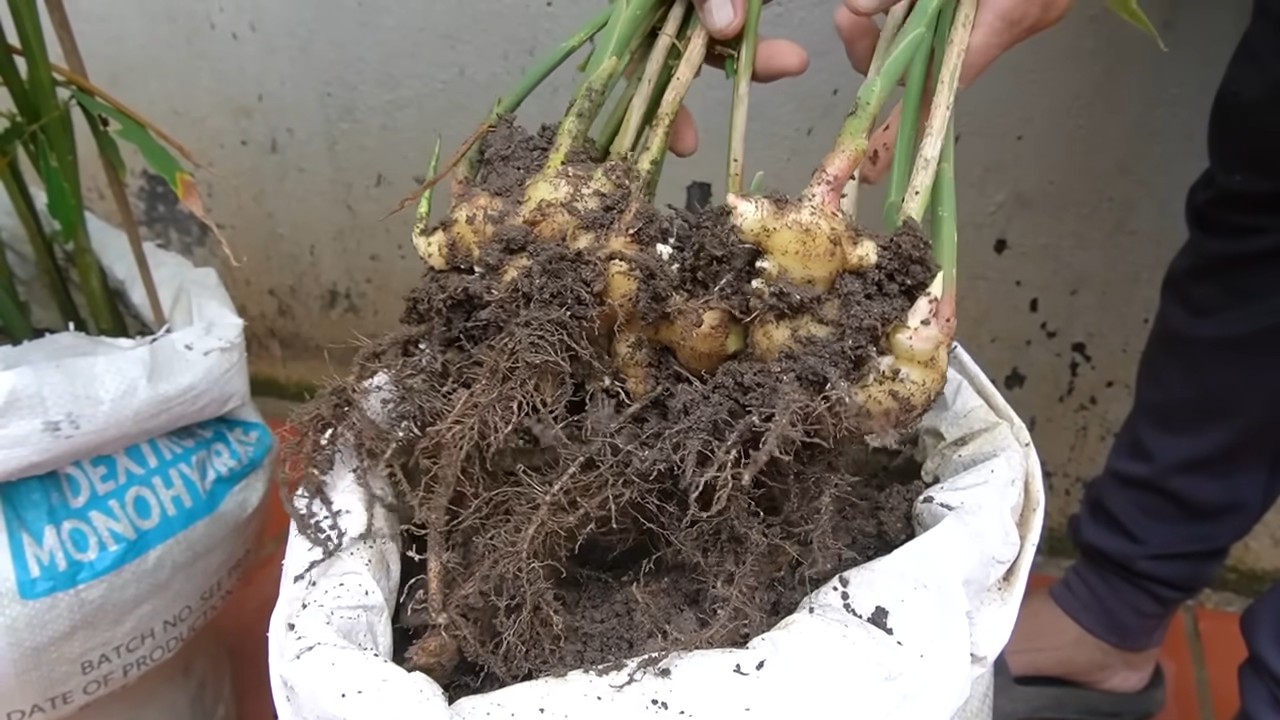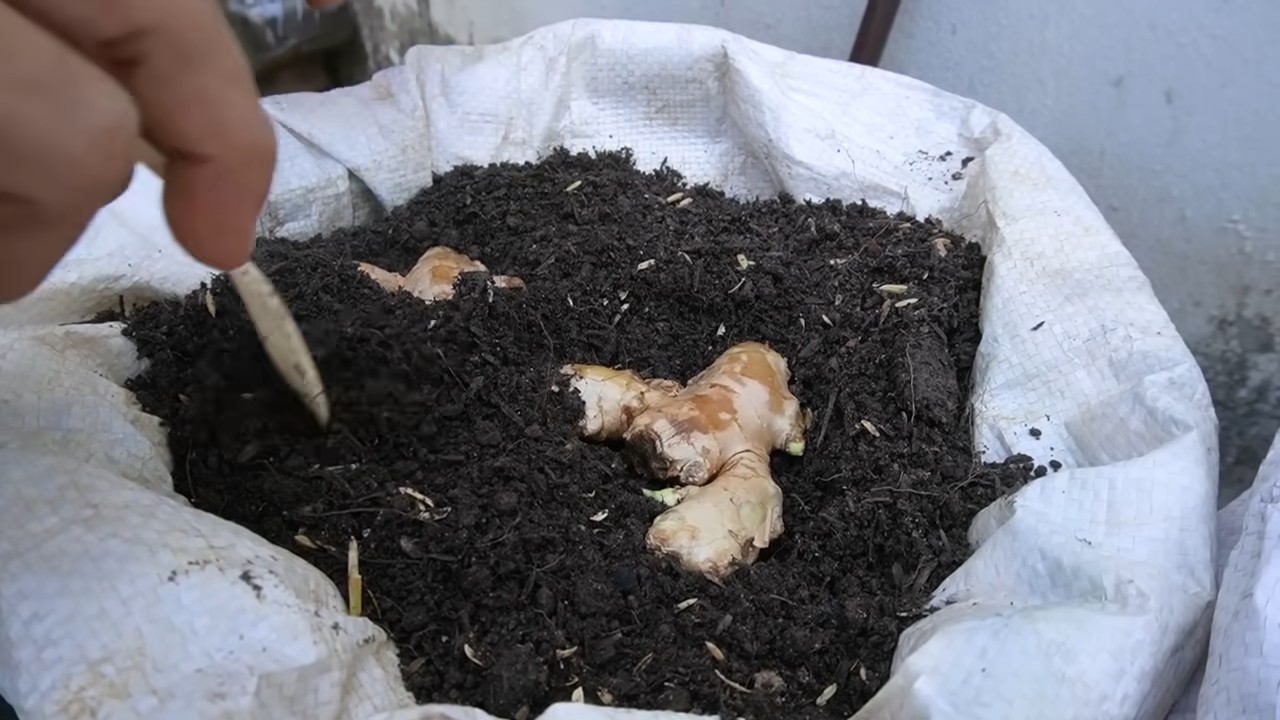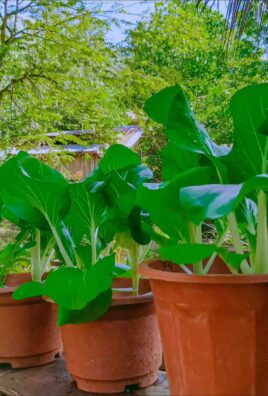Grow ginger at home, and unlock a world of fresh, flavorful possibilities right in your own kitchen! Imagine stepping outside your door and harvesting your own spicy, aromatic ginger whenever you need it. No more last-minute grocery store runs or settling for less-than-fresh roots. This isn’t just about convenience; it’s about connecting with nature and experiencing the satisfaction of nurturing your own food.
Ginger, with its zesty bite and warming properties, has been cherished for centuries across various cultures. From ancient Ayurvedic medicine to traditional Chinese remedies and culinary traditions worldwide, ginger has played a vital role. Historically, it was even considered a valuable trade commodity, traveling along spice routes and enriching cuisines across continents.
But why should *you* learn to grow ginger at home? Well, store-bought ginger can sometimes be expensive or lack the vibrant flavor of freshly grown roots. Plus, knowing exactly where your food comes from and how it’s grown offers peace of mind. In this article, I’ll share simple, step-by-step DIY tricks and hacks that will empower you to cultivate your own thriving ginger patch, even if you have limited space or gardening experience. Get ready to embark on a rewarding journey and enjoy the delicious rewards of homegrown ginger!

Grow Your Own Ginger: A Beginner’s Guide
Hey there, fellow plant enthusiasts! Ever thought about growing your own ginger? It’s surprisingly easy and rewarding, and nothing beats the flavor of fresh, homegrown ginger. Plus, it’s a fantastic way to add a touch of the exotic to your garden or even your windowsill. I’m going to walk you through everything you need to know to successfully cultivate your own ginger at home.
What You’ll Need
Before we dive in, let’s gather our supplies. This is a pretty straightforward project, so you won’t need anything too fancy.
* Ginger Rhizome: Look for a plump, healthy-looking ginger rhizome at your local grocery store or nursery. Ideally, it should have visible “eyes” (small buds) on it. Organic ginger is often a better choice, as it’s less likely to have been treated with growth inhibitors.
* Potting Mix: A well-draining potting mix is crucial. I recommend a mix of equal parts potting soil, perlite, and compost. This ensures good drainage and provides the ginger with the nutrients it needs.
* Pot: Choose a pot that’s at least 12 inches in diameter and 12 inches deep. Ginger roots grow horizontally, so a wider pot is better than a taller one. Make sure the pot has drainage holes.
* Watering Can: A watering can with a gentle rose is perfect for watering your ginger without disturbing the soil.
* Spray Bottle: This will be used to mist the ginger, especially in the early stages of growth.
* Optional: Organic fertilizer (like compost tea or fish emulsion) to give your ginger a boost.
Preparing the Ginger Rhizome
This is a crucial step to get your ginger off to a good start.
1. Soaking (Optional but Recommended): I like to soak my ginger rhizome in lukewarm water for 12-24 hours before planting. This helps to rehydrate it and encourages the “eyes” to sprout.
2. Cutting (If Necessary): If your ginger rhizome is large, you can cut it into smaller pieces, ensuring that each piece has at least one or two “eyes.” Let the cut pieces air dry for a day or two to allow the cut surfaces to callous over. This helps prevent rot.
3. Choosing the Right Piece: Select a piece of ginger that feels firm and has visible buds (eyes). Avoid any pieces that are soft, shriveled, or moldy.
Planting Your Ginger
Now for the fun part – getting your ginger in the soil!
1. Fill the Pot: Fill your pot with the well-draining potting mix, leaving about an inch or two of space at the top.
2. Planting the Rhizome: Place the ginger rhizome on top of the soil, with the “eyes” facing upwards.
3. Covering the Rhizome: Gently cover the rhizome with about 1-2 inches of soil. Don’t bury it too deep, as this can hinder sprouting.
4. Watering: Water the soil thoroughly until water drains out of the drainage holes.
5. Placement: Place the pot in a warm, humid location with indirect sunlight. Ginger thrives in bright, but not direct, sunlight. An east-facing window is often ideal.
Caring for Your Ginger Plant
Consistent care is key to a healthy and productive ginger plant.
1. Watering: Keep the soil consistently moist, but not soggy. Water when the top inch of soil feels dry to the touch. Overwatering can lead to root rot, so be careful not to overdo it.
2. Humidity: Ginger loves humidity. If you live in a dry climate, mist the plant regularly with a spray bottle. You can also place the pot on a tray filled with pebbles and water. As the water evaporates, it will increase the humidity around the plant.
3. Temperature: Ginger prefers warm temperatures, ideally between 65°F and 80°F (18°C and 27°C). Avoid exposing the plant to cold drafts or temperatures below 50°F (10°C).
4. Fertilizing: Feed your ginger plant every 2-3 weeks with a diluted organic fertilizer, such as compost tea or fish emulsion. This will provide the plant with the nutrients it needs to grow strong and healthy.
5. Sunlight: While ginger needs bright light, direct sunlight can scorch the leaves. Place the plant in a location that receives indirect sunlight for at least 6 hours a day.
6. Pest Control: Ginger is relatively pest-resistant, but keep an eye out for common houseplant pests like aphids or spider mites. If you spot any pests, treat them with an organic insecticide or insecticidal soap.
Harvesting Your Ginger
Patience is a virtue when it comes to harvesting ginger, but the wait is worth it!
1. When to Harvest: You can start harvesting ginger about 8-10 months after planting. The leaves will start to turn yellow and die back, indicating that the rhizome is mature.
2. Harvesting Method: Gently dig around the plant and lift the rhizome out of the soil. You can harvest the entire rhizome or just a portion of it, leaving the rest to continue growing.
3. Cleaning: Wash the harvested ginger rhizome thoroughly to remove any dirt or debris.
4. Storing: Freshly harvested ginger can be stored in the refrigerator for several weeks. You can also freeze it for longer storage. To freeze ginger, peel it and then grate or slice it before placing it in an airtight container or freezer bag.
Troubleshooting
Even with the best care, you might encounter a few challenges along the way. Here are some common issues and how to address them:
* Yellowing Leaves: This could be a sign of overwatering, underwatering, or nutrient deficiency. Check the soil moisture and adjust your watering accordingly. If the soil is consistently moist, reduce your watering frequency. If the soil is dry, water more often. You can also try fertilizing the plant with a diluted organic fertilizer.
* Root Rot: This is usually caused by overwatering. If you suspect root rot, carefully remove the plant from the pot and inspect the roots. If the roots are brown and mushy, trim away the affected areas and repot the plant in fresh, well-draining potting mix.
* Slow Growth: This could be due to insufficient light, temperature, or nutrients. Make sure the plant is receiving adequate indirect sunlight and is kept in a warm location. Fertilize the plant regularly with a diluted organic fertilizer.
* No Sprouting: Sometimes, the ginger rhizome may take a while to sprout. Be patient and continue to keep the soil consistently moist. If the rhizome still hasn’t sprouted after a few weeks, gently dig it up and check for signs of rot. If the rhizome is healthy, replant it and continue to monitor it.
Propagating Ginger
Once you’ve successfully grown ginger, you can easily propagate it to create more plants.
1. Dividing the Rhizome: When you harvest your ginger, you can divide the rhizome into smaller pieces, ensuring that each piece has at least one or two “eyes.”
2. Planting the Divisions: Plant the divisions in separate pots filled with well-draining potting mix, following the same planting instructions as above.
3. Caring for the New Plants: Care for the new plants as you would your original ginger plant.
Enjoying Your Homegrown Ginger
Now that you’ve harvested your own ginger, it’s time to enjoy the fruits (or rather, rhizomes) of your labor!
* Cooking: Fresh ginger adds a wonderful flavor to stir-fries, soups, curries, and other dishes.
* Tea: Ginger tea is a soothing and warming beverage that can help with digestion and nausea. Simply steep a few slices of fresh ginger in hot water for 5-10 minutes.
* Baking: Ginger can be used in a variety of baked goods, such as gingerbread, cookies, and cakes.
* Medicinal Uses: Ginger has been used for centuries for its medicinal properties. It can help with nausea, inflammation, and pain relief.
Extra Tips for Success
* Choose the Right Variety: While most ginger varieties will grow well indoors, some are better suited for container gardening. Look for varieties like ‘Canton’ or ‘Rio de Janeiro.’
* Use a Self-Watering Pot: If you tend to forget to water your plants, a self-watering pot can be a lifesaver.
* Monitor for Pests Regularly: Catching pests early is key to preventing infestations. Inspect your plant regularly for signs of pests and take action immediately if you spot any.
* Don’t Be Afraid to Experiment: Gardening is all about learning and experimenting. Don’t be afraid to

Conclusion
So, there you have it! Growing ginger at home is not only achievable, but it’s also a rewarding and surprisingly simple process. Forget those expensive trips to the grocery store for a knob of fresh ginger; imagine the satisfaction of harvesting your own vibrant, flavorful rhizomes right from your windowsill or garden. This DIY trick is a must-try for anyone who appreciates fresh ingredients, enjoys a bit of gardening, or simply wants to add a touch of green to their living space.
Why is this a must-try? Because the flavor of homegrown ginger is undeniably superior. It’s zestier, more aromatic, and bursting with a freshness you just can’t replicate with store-bought varieties that have often traveled long distances and lost some of their potency. Plus, you have complete control over the growing process, ensuring your ginger is free from harmful pesticides and chemicals.
But the benefits extend beyond just flavor. Growing ginger at home is a sustainable practice, reducing your carbon footprint by minimizing transportation needs. It’s also a fantastic way to connect with nature, learn about plant life cycles, and experience the joy of nurturing something from start to finish. And let’s not forget the aesthetic appeal – a lush ginger plant adds a touch of tropical beauty to any indoor or outdoor space.
Looking for variations? Consider experimenting with different varieties of ginger. While common ginger (Zingiber officinale) is the most readily available, you might be able to find other types like galangal or turmeric, which can be grown using similar methods. You can also adjust the growing conditions to influence the flavor profile. For example, slightly drier conditions might result in a spicier ginger, while more humid conditions could yield a milder flavor.
Another fun variation is to grow ginger in containers of different sizes and materials. Try using terracotta pots for better drainage or upcycled containers for a more eco-friendly approach. You can even create a miniature ginger garden by combining ginger with other complementary herbs and spices like mint, lemongrass, or chili peppers.
Don’t be intimidated if you’ve never grown anything before. Growing ginger at home is a forgiving process, and even beginners can achieve success with a little patience and attention. The key is to provide the right conditions: warmth, humidity, and well-draining soil.
We wholeheartedly encourage you to give this DIY trick a try. It’s an investment in fresh flavor, sustainable living, and a deeper connection with nature. Once you’ve harvested your first batch of homegrown ginger, you’ll be hooked!
And most importantly, we want to hear about your experience! Share your photos, tips, and stories with us in the comments below. Let us know what challenges you faced, what successes you celebrated, and what delicious recipes you created with your homegrown ginger. Together, we can build a community of ginger-growing enthusiasts and inspire others to embrace the joys of DIY gardening. So, get your ginger rhizomes ready, prepare your soil, and embark on this exciting journey of growing ginger at home!
Frequently Asked Questions (FAQ)
What kind of ginger should I use to start growing?
You’ll want to use fresh ginger rhizomes from a grocery store or nursery. Look for plump, healthy-looking rhizomes with visible “eyes” or buds. Organic ginger is often recommended, as it’s less likely to have been treated with growth inhibitors. Avoid using powdered or pickled ginger, as these won’t sprout.
How long does it take to grow ginger at home?
The time it takes to grow ginger at home can vary depending on the growing conditions, but generally, it takes around 8-10 months from planting to harvest. You can start harvesting small pieces of ginger after about 4 months, but for a full harvest, it’s best to wait until the plant has matured.
What kind of soil is best for growing ginger?
Ginger prefers well-draining, nutrient-rich soil. A good mix would be equal parts potting soil, compost, and perlite or vermiculite. This combination provides the necessary drainage, aeration, and nutrients for healthy ginger growth. Avoid heavy clay soils, as they can retain too much moisture and lead to root rot.
How much sunlight does ginger need?
Ginger thrives in partial shade. Direct sunlight can scorch the leaves, so it’s best to provide protection from the intense afternoon sun. A spot that receives morning sun and afternoon shade is ideal. If you’re growing ginger indoors, place it near a bright window but away from direct sunlight.
How often should I water my ginger plant?
Water your ginger plant regularly, keeping the soil consistently moist but not waterlogged. Allow the top inch of soil to dry out slightly between waterings. During the growing season (spring and summer), you may need to water more frequently than during the dormant season (fall and winter).
How do I know when to harvest my ginger?
You’ll know it’s time to harvest when the leaves start to turn yellow and die back. This usually happens in the fall or early winter. You can either harvest the entire plant or dig up only the amount of ginger you need, leaving the rest to continue growing.
Can I grow ginger indoors?
Yes, you can absolutely grow ginger indoors! In fact, it’s a great way to enjoy fresh ginger year-round, especially if you live in a colder climate. Just make sure to provide the right conditions: warmth, humidity, and adequate light. A humidifier or regular misting can help maintain the necessary humidity levels.
What are some common problems when growing ginger?
Some common problems when growing ginger include root rot, pests, and nutrient deficiencies. Root rot can be prevented by using well-draining soil and avoiding overwatering. Pests like aphids and spider mites can be controlled with insecticidal soap or neem oil. Nutrient deficiencies can be addressed by fertilizing with a balanced organic fertilizer.
How do I store my harvested ginger?
Freshly harvested ginger can be stored in the refrigerator for several weeks. Wrap it in a paper towel and place it in a plastic bag to prevent it from drying out. You can also freeze ginger for longer storage. Simply peel and chop the ginger into smaller pieces, then freeze them in a single layer on a baking sheet before transferring them to a freezer bag.
Can I grow ginger from store-bought ginger?
Yes, you can grow ginger from store-bought ginger, but it’s important to choose rhizomes that are healthy and plump with visible buds. Organic ginger is often a better choice, as it’s less likely to have been treated with growth inhibitors. Soak the ginger in water overnight before planting to encourage sprouting.
What fertilizer should I use for growing ginger?
Use a balanced organic fertilizer with an NPK ratio of around 10-10-10 or 5-5-5. You can also use compost tea or worm castings to provide essential nutrients. Fertilize your ginger plant every 2-3 weeks during the growing season.
Is growing ginger at home worth the effort?
Absolutely! Growing ginger at home is a rewarding experience that provides you with fresh, flavorful ginger, a connection with nature, and a sustainable way to source your ingredients. The taste of homegrown ginger is far superior to store-bought varieties, and you have complete control over the growing process. So, give it a try and experience the joys of growing ginger at home!





Leave a Comment